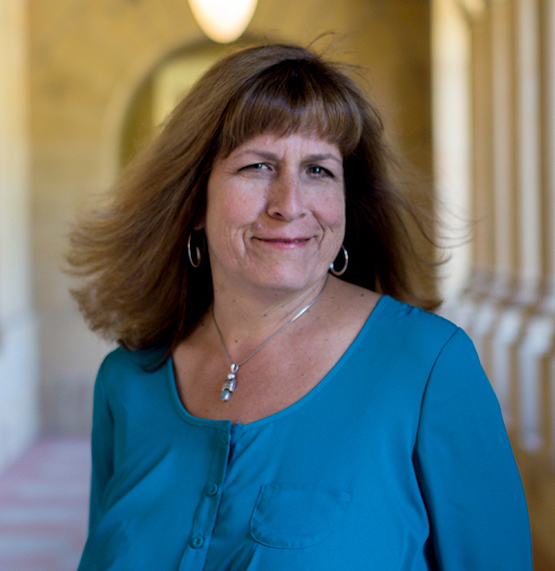Preservation Week: 5 questions with Cathy Aster

This week, libraries around the country will share preservation tips and stories for the American Library Association’s annual Preservation Week. You can find preservation resources, quick tips, and free webinars on the Preservation Week site covering the spectrum of collection care from textiles to personal digital archives. We will spend this week meeting some of the people that support preservation and conservation activities across Stanford Libraries. Team members from Preservation and Digital Library Systems and Services have answered five questions about themselves and their work on the long-term care of our books, archives, audio-visual resources, and born-digital files.
We kick off our Preservation Week posts with Cathy Aster, Service Manager in Digital Library Systems and Services.
Tell us about your work.
I am a service manager in Digital Library Systems and Services. In my role, I manage both services and projects, and I also work as a product owner with software engineers, operations staff and designers for the digital library applications I help support.
I am the service manager for: Stanford’s Electronic Thesis and Dissertation Submission Program, Stanford’s exhibit platform - called Spotlight, and the Libraries’ map program in collaboration with staff from the David Rumsey Map Center.
I also manage numerous digital collection projects, in support of digitization and/or digital library content, preserving in the Stanford Digital Repository and bringing to light collections in SearchWorks and Spotlight.
I am the Product and Service Management team liaison to the Bowes Art and Architecture Library, and to the Libraries' Technical Services department, which includes the Preservation Department.
What is your favorite book/item to come across your bench in the past year?
In this case, it is a favorite digitized collection. With colleagues in Digital Library Systems and Services and the Metadata Department, we worked with a Stanford colleague affiliated with the Center for Spatial and Textual Analysis, along with a globally distributed team to support their Mapping Rome project. We provided project management and metadata support to accession their 4,000-item digital collection into the Stanford Digital Repository, and showcase it online in the Images of Rome - The Rodolfo Lanciani Digital Archive exhibit.
With so much change in preservation in the last two years, what's been the most fun/most challenging?
As the liaison to the Stanford Libraries’ Preservation Department, I’m fortunate to work a fair amount with Kristen St. John. Kristen’s enthusiasm and commitment to leveraging digital library tools and services to help fulfill the mission of the Conservation Services program are impressive. Kristen and I worked together to set up a JIRA project to create tickets for all library materials entering the lab for conservation work, and this has improved tracking and transparency immeasurably. In addition, Digital Library Systems and Services assisted Kristen by setting up a Stanford Digital Repository collection where she and her staff can deposit written and photographic conservation treatment documentation. This content will be linked to library item records, providing unparalleled access to conservation provenance. This is an exciting convergence of traditional conservation with the tools available in the digital library world.
Why did you decide to go into this field?
I majored in Art History as an undergraduate, at the University of Texas at Austin. During a seminar on prints and drawings, the professor arranged a tour for us in the paper conservation lab of the Harry Ransom Center on campus. I was hooked, and knew that I had found my calling. The tour served as a touchstone as I searched for meaningful employment after graduation, and I was fortunate to be hired as an Assistant Rare Book Conservator (in training) by Don Etherington in 1985, then director of the Harry Ransom Center Book Conservation Lab. I’ve worked for academic research libraries ever since; although my career path has morphed into digital library work, my conservation foundation solidified my passion for preserving and sharing library and archives content with users around the world.
What's something about your job we'd be surprised to learn?
This question provides the chance to share a bit about a former job at the Beinecke Rare Book and Manuscript Library, where I was hired to repair and house their large papyrus collection. I was fortunate to receive training from a skilled papyrologist, alongside support from colleagues in the Sterling Memorial Library conservation department. The oldest fragment I had the opportunity to work with was from about 1500 BCE.
Can you recommend some books/websites/articles about your field?
I am pleased to be able to highlight the work of the Digital Library Federation here:
“…a robust and ever more diverse and inclusive community of practitioners who advance research, learning, social justice, and the public good through the creative design and wise application of digital library technologies.”
With energetic leadership and an ever-increasing sense of relevance in today’s challenging world, I consider DLF my professional organization “home.”
